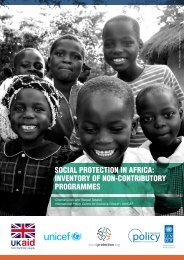https://goo.gl/sZ7V7x
293g79C
293g79C
You also want an ePaper? Increase the reach of your titles
YUMPU automatically turns print PDFs into web optimized ePapers that Google loves.
Home-Grown School Feeding Programme<br />
Programme<br />
Home-Grown School Feeding Programme<br />
Country<br />
Zambia<br />
Geographic area<br />
Sub-Saharan Africa<br />
Previous programme name (if any)<br />
Start date 2003 1<br />
Programme objectives<br />
To improve the learning outcomes of students by providing<br />
meals at schools, preferably made from produce procured<br />
from smallholder farmers. 1<br />
Programme type<br />
Conditional in-kind transfer<br />
Programme components<br />
Conditionalities (if any)<br />
School attendance<br />
Targeting methods<br />
Geographical and categorical targeting.<br />
Target areas<br />
31 districts in eight provinces.<br />
The districts targeted by the programme have high levels<br />
of food insecurity, HIV infection, poverty and malnutrition and<br />
low levels of educational achievement. The saturation principle<br />
(covering all schools in the area) is employed in the targeted districts. 1,2<br />
Target groups Primary-school students 3<br />
Eligibility criteria Children must be enrolled in primary schools (grades 1–9)<br />
within the districts targeted by the programme. 3<br />
Eligibility reassessment (if any)<br />
Type of benefits<br />
Food<br />
Amount of benefits<br />
Students receive a daily meal of 100 grams of fortified maize.<br />
The estimated cost of each meal is of ZMK520 (USD0.10), which implies<br />
a transfer value of ZMK15,500 per month (USD3.12) to beneficiaries. 3<br />
Payment/delivery frequency Daily 1<br />
Benefit delivery mechanism The food is prepared and delivered at schools. 3<br />
Benefit recipients<br />
Students<br />
Minimum and maximum<br />
180 days of the school year 3<br />
duration of benefits (if any)<br />
Coverage 890,000 children in 2,200 schools (2015) 4<br />
Programme expenditure ZMW8.8 million or USD9 million (2014) 4<br />
Institutions and agencies involved World Food Programme (WFP); Ministry of General Education 1<br />
Monitoring and evaluation<br />
mechanisms and frequency<br />
The most recent evaluation of the programme<br />
was carried out by the WFP in 2011. 3<br />
See the references on page 196: Home-Grown School Feeding Programme<br />
154 | Social Protection in Africa: inventory of non-contributory programmes



